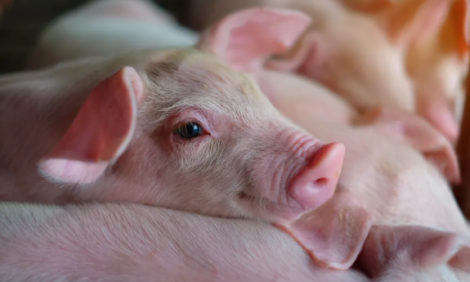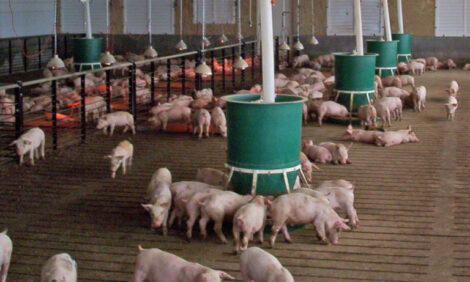



Brazil: Livestock and Products: Annual Livestock Report 2008
USDA Foreign Agricultural Service GAIN Report by Joao F. Silva, Agricultural Specialist. A link to the full report is provided. Pork production is expected to increase in 2009 as the sector will likely benefit from higher exports and stable domestic demand.Report Highlights on Beef and Pork
The outlook for beef production and exports calls for a small rebound in 2009. The sector faces new challenges due to a restructuring of Brazil’s cattle sector and lower beef export volume. Domestic demand for beef is expected to remain the main driver of the sector’s performance in spite of rising retail beef prices, since consumer’s real incomes continue to rise with a projected growing economy in 2009.
Pork production is also expected to increase in 2009 as the sector will likely benefit from higher exports and stable domestic demand. However, higher costs of production for beef and pork as well as lower profitability margins are key uncertainties for 2009.
Executive Summary
Cattle and beef production in 2009 is face new challenges such as lower availability of cattle for slaughter, increasing production costs, and reduced export volume for the first time in a decade stemming from restrictions imposed by the European Union and a slow down in world demand due to higher beef prices. Among the positive factors are booming export earnings due to the higher export value of beef and firm domestic demand based on a projected 4 percent economic growth rate in 2009 and rising consumer purchasing power.
The outlook for pork calls for continued increase in production and exports, as well as increases in production costs due to higher feed costs.
Commodity Outlook, Swine and Pork
Production
Post projects pork production to increase in 2009 by 3 per cent reflecting firm domestic demand and continued increase in exports. The increase in production assumes that production costs will likely moderate in the upcoming crop year, as current projections call for large corn and soybean crops.
Near 60 per cent of pork production in Brazil is concentrated in the three southern states of Santa Catarina, Parana and Rio Grande do Sul. Santa Catarina, which accounts for 25 per cent of the total Brazilian pork production, was recently declared as free of foot and mouth disease (FMD) without vaccination by the World Organisation for Animal Health, OIE.
Because production in these states is highly vertically integrated, returns are likely expected for hog producers in these areas because of the strong support (genetics and financing) from the large pork packers. During Jan-Jul 2008, hog production costs (live weight per kilogram) in the state of Santa Catarina, increased by 26 per cent compared to the same period in 2007. However, in the same period, the price of live hog per kilogram increased by 42 per cent.
Consumption
Domestic consumption of pork is projected to continue stable in 2009, despite competition from beef and broilers. The higher price of beef in the domestic market had a moderate impact on pork consumption, as pork is third in Brazilian preference for meats, after beef and chicken. Pork utilization in Brazil is estimated at 70 per cent for industrial/processing and 30 per cent for fresh consumption.
The increase in domestic pork consumption is due to stronger market promotion conducted jointly by producers and packers to increase per-capita domestic consumption of fresh pork in Brazil. Promotional activities for pork started in the Centre-south of the country but it has expanded to other major cities in the south-east.
Pork producers remain concerned about the seasonal trend of fresh pork consumption in Brazil that is concentrated during the winter months (June-August), and are trying to address this concern with their campaign to promote the benefits of year-round pork consumption. Pork producers also are trying to close the gap between the regions of Brazil in terms of pork consumption. Currently, per-capita pork consumption is concentrated in the South with per-capita consumption at 18kg and the South-east at 15kg, while the Centre-west (11kg) and North-east (6kg) regions consume less pork.
Trade
The outlook for 2009 calls for an increase in pork exports of about 4 per cent as Brazil continues to expand shipments to non-traditional markets, although exports are still concentrated in the Russian market. Local exporters are concerned with the long-term impact of this concentration because of Russia’s increase in pork production. During Jan-July 2008, pork exports to Russia declined by 11 per cent in volume, although the export value increased by nearly 30 per cent. The strong demand for pork in Asia also stimulated the increase in the value of Brazil’s exports to nearly all destinations during the first half of 2008.
Brazil is still negotiating market access for pork with China, Japan, South Korea and Philippines. Now that the state of Santa Catarina is free of FMD without vaccination, the Brazilian government is pressuring these countries for market access. Also, in 2008, the U.S. Department of Agriculture sent the first technical team to Santa Catarina to begin a risk assessment for Brazilian pork.
Stocks
There are no government held stocks for pork in Brazil.
Policy
There are no major changes in policies for pork production and exports. Brazilian packers remain eligible for all production and export financing programs listed in GAIN 5622.
Marketing
Market promotion remains targeted at major world trade shows but focused on specific markets with potential export growth. The Brazilian Pork Processors and Exporters Association (ABIPECS) renewed its agreement with APEX for over US$4.1 million for market promotion activities during 2008/09, of which APEX will fund 50 per cent. Target overseas markets include Asia, East European countries, the European Union and other countries in Latin America.

Further Reading
| - | You can view the full report by clicking here. |
Other Reports in this Series
To view our complete list of 2008 Livestock and Products Annual Reports covering pigs from USDA FAS GAIN, please click hereSeptember 2008








